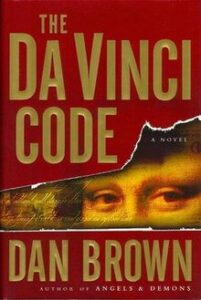Dan Brown’s novel, “The Da Vinci Code,” is the subject of an enthralling book that is packed with thrilling suspense. The story unfolds through the adventures of Robert Langdon, a Harvard professor of religious symbology, and Sophie Neveu, a cryptologist.
Amid a conflict between the Priory of Sion and Opus Dei over Jesus and Mary Magdalene’s child. The novel is a fast-paced mystery that involves the unraveling of secrets of the ancient Priory of Sion and the Knights Templar.
The Da Vinci Code Characters and Plot Explained
The main characters, Robert Langdon and Sophie Neveu, are drawn into a complex mystery that requires them to decipher codes and unravel historical secrets. The plot is full of unexpected turns, keeping readers engaged.
Let’s go and try to know more about our Characters here:
Robert Langdon: Robert Langdon is the male protagonist of the novel. A professor of symbology at Harvard, Langdon is honest, trustworthy, and an extremely successful academic. He studies religion but does not follow a particular faith, preferring to observe from the outside.
Sophie Neveu: Sophie Neveu, the female protagonist of the novel, is a cryptologist with the French Judicial Police. Through a tragic car accident claiming the lives of her parents, brother, and grandmother She was Left only with her Grandfather who brought her up. Sophie has a strong fondness for all types of puzzles, and she thoroughly enjoys solving them.
Leigh Teabing: Leigh Teabing is a historian and the antagonist of the novel. Sir Leigh Teabing holds the title of a knight, and he is also a Royal Historian. Additionally, he is known for his immense wealth. He has been affected by polio and is currently unmarried. The Holy Grail has been his passion for years.
Manuel Aringarosa: Manuel Aringarosa is the Bishop of Opus Dei. Aringarosa, a conservative, wants the Church to return to strict ways.
Sister Sandrine Bieil: Sister Sandrine Bieil is a nun and keeper of the Church of Saint-Sulpice. She favors the loosening of church strictures and modernizing of the church.
Marie Chauvel: Marie Chauvel is Sophie’s grandmother and Saunière’s wife. A woman of intelligence and kindness, Mary Chauvel plays a crucial part in the Priory’s efforts to keep their secret safe.
Jerome Collet: Jerome Collet is an agent with the French Judicial Police. In his pursuit of Sophie and Langdon, Collet makes several mistakes.
An In-Depth Look Into The Plot Of The Da Vinci Code
Dan Browns “The Da Vinci Code” follows Robert Langdon and Sophie Neveu, who unravel a religious riddle within the Louvre Museum. This riddle, preserved by a secret society, could shake Christianity’s core. The conflict between the Priory of Sion and Opus Dei centers around the idea of Jesus Christ and Mary Magdalene having a child.
The Murder and the Mystery-Filled Plot:
The story of “The Da Vinci Code” begins with a murder at the Louvre Museum. Jacques Saunière, the museum’s curator, is apprehended by Silas, a monk of Opus Dei. Silas demands to know the location of the Holy Grail. After Saunière informs him of something, Silas shoots him and abandons him to his fate. Saunière has given false information about the location of the Grail.
The Clues and the Chase Of The Characters:
Saunière, realizing he has only a few minutes left to live and needing to pass on his important secret, uses his blood to paint a pentacle on his stomach. He then draws a circle around himself and drags his body into the center of the circle, mimicking the position of Da Vinci’s Vitruvian Man. He leaves a line of numbers, a code, and 2 lines of text in invisible ink on the ground.
The Investigation Into the Mystery:
A police detective named Jerome Collet contacts Robert Langdon, a professor of symbology, and requests that he come to the Louvre to interpret a mysterious scene. Langdon does not yet realize that he is suspected of the murder.
The Revelation Of The Unknown:
Sophie Neveu, granddaughter of Saunière and an agent of the Department of Cryptology, arrives at the crime scene and instructs Langdon to call the embassy. After receiving the phone number from Sophie, Langdon calls it and is directed to her answering service. The message advises Langdon to meet Sophie in the Louvre bathroom due to danger.
The Escape From Other Party:
In the bathroom, Sophie shows Langdon that Fache is tracking his movements with a device. She throws the device out of the window onto a passing truck, misleading the police into thinking that Langdon has escaped from the Louvre.
The Secret Society:
Sophie informs Langdon that her grandfather used the initials P.S. As a reference to her nickname, Princess Sophie, the message includes a postscript that says “P.S.” Langdon believes P.S. refers to the Priory of Sion, an ancient brotherhood devoted to preserving pagan goddess worship and the secret Saunière died protecting.
Themes And Analysis Of The Da Vinci Code
“The Da Vinci Code” explores themes such as religion, history, and art. It challenges traditional interpretations of religious history and presents an alternative narrative that has sparked debates among readers. Let’s talk about some of the enticing themes this book presents.

The Human World is Encoded with Meaning
One of the central themes of “The Da Vinci Code” is the idea that the human world is encoded with meaning, and symbology is a way of deciphering it. This theme is embodied in the character of Robert Langdon, a professor of symbology, who uses his knowledge to decode the world around him.
The Need to Reclaim a Holistic Spirituality
The novel also emphasizes the need to reclaim a holistic spirituality for humankind, especially the feminine aspect. This theme is explored through the concept of the sacred feminine and the suggestion that ancient societies revered a balance between male and female deities.
The Power and Danger of Belief, Faith, and Fanaticism
“The Da Vinci Code” explores the power and danger of belief, faith, and fanaticism. Bishop Aringarosa’s character embodies the dangers of blind faith and religious fanaticism.
The Subjectivity of Art and History
The novel raises questions about the subjectivity of art and history, suggesting the possibility of alternative interpretations. This theme is explored through reinterpretations of commonly told stories, such as those of Jesus’ life, the pentacle, and Da Vinci’s fresco “The Last Supper”.
The Intelligence of Women
Finally, “The Da Vinci Code” highlights the intelligence of women. Characters in the novel ignore the power of women at their peril. Throughout the novel, Sophie Neveu is underestimated. She saves Langdon from arrest countless times. Other women are similarly underestimated.
Symbolism Is Explained
Symbols play a significant role in “The Da Vinci Code”. The novel is filled with references to historical symbols and their interpretations. For instance, Leonardo da Vinci’s artwork is analyzed for hidden meanings and symbols related to the Holy Grail.
Were Near the End
In conclusion, “The Da Vinci Code” is a thought-provoking novel that combines elements of mystery, history, art, suspense and religion. Its intricate plot, interesting characters, and exploration of controversial themes have made it one of the most popular books in recent years.

